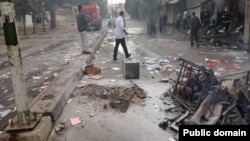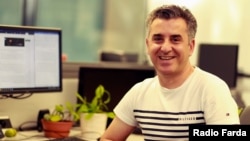
Protesters in Iran have clashed with police again as some in the western city of Mahabad attempted to occupy government buildings as officials tried to link the demonstrations -- sparked by the death of a young woman while in police custody for allegedly improperly wearing a head scarf -- to a deadly attack on a mosque claimed by the Islamic State militant group.
Footage posted on social media by activists showed large crowds of people surrounding the governor's building on October 27, heaving rocks and other debris at the gates as sporadic gunfire echoes in the background.
The city was on edge after the body of 35-year-old Ismail Moloudi was buried earlier in the day.
Moloudi was killed the day before by officers of the Islamic Revolutionary Guards Corps during a protest marking 40 days since 22-year-old Mahsa Amini died while being detained by police. Eyewitnesses say she was beaten by security agents, but the government says she died of "underlying diseases."
The Hengaw human rights organization said there were reports that some demonstrators in Mahabad had been shot. It was not possible to independently verify the reports.
In another western Iranian city, Khorramabad, hundreds of people gathered near a cemetery where Nika Shakarami -- a 16-year-old died after participating in anti-government protests in Tehran on September 20 -- is buried.
Shakarami went missing in Tehran after telling a friend she was being chased by police.
Amnesty International said Iranian security forces have killed at least eight people since the evening of October 26.
"Iran's security forces killed at least eight people since last night as they again opened fire on mourners and protesters," Amnesty said on October 27, condemning the "reckless and unlawful use of firearms."
As thousands of Iranians descended on October 26 on the cemetery where Amini is buried -- in defiance of warnings from authorities -- an attack claimed by Islamic State killed at least 15 people at a shrine in the southern city of Shiraz.
President Ebrahim Raisi on October 27 appeared to link the attack with the protests by saying that "the intention of the enemy is to disrupt the country's progress, and then these riots pave the ground for terrorist acts."
Several leading Iranian officials have blamed the protests on foreign influences, mainly the United States and Israel. They have not shown any evidence to back up their claims.
Meanwhile the scope of the protests continues to widen, with a number of doctors in Tehran holding a rally on October 26 in front of the forensic medicine building.
Reports said 15 doctors were arrested at the gathering, prompting the president and vice president of the Tehran Medical Council to resign.
The government has met the protests with a harsh crackdown that the Oslo-based group Iran Human Rights says has left at least 215 people, including 27 children, dead.








